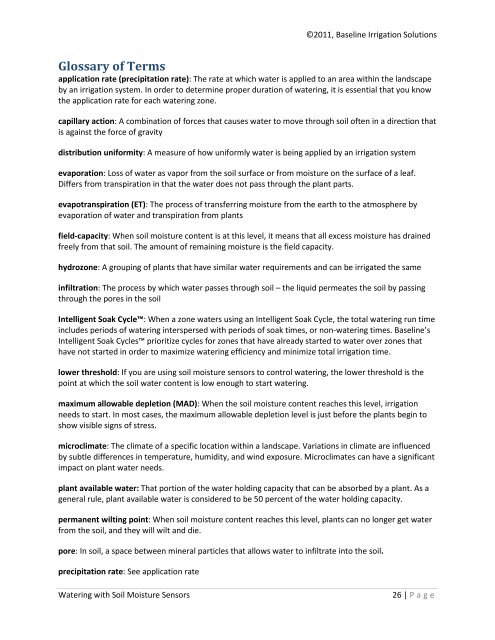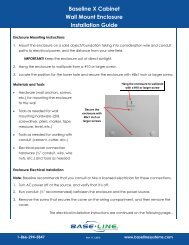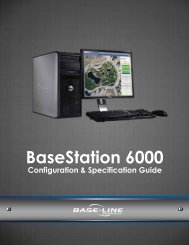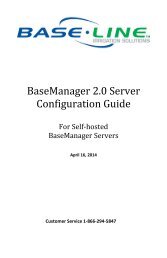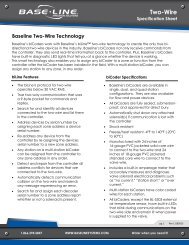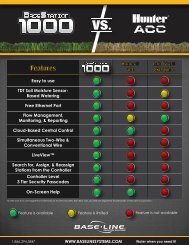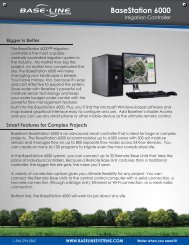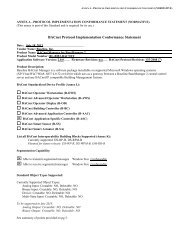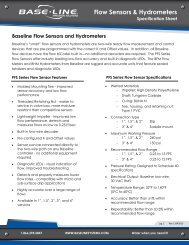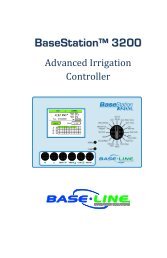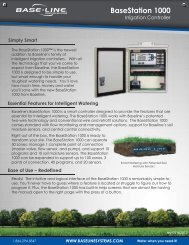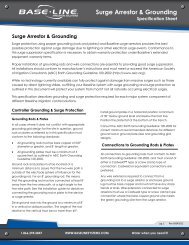Watering with Soil Moisture Sensors - Baseline Systems
Watering with Soil Moisture Sensors - Baseline Systems
Watering with Soil Moisture Sensors - Baseline Systems
You also want an ePaper? Increase the reach of your titles
YUMPU automatically turns print PDFs into web optimized ePapers that Google loves.
©2011, <strong>Baseline</strong> Irrigation SolutionsGlossary of Termsapplication rate (precipitation rate): The rate at which water is applied to an area <strong>with</strong>in the landscapeby an irrigation system. In order to determine proper duration of watering, it is essential that you knowthe application rate for each watering zone.capillary action: A combination of forces that causes water to move through soil often in a direction thatis against the force of gravitydistribution uniformity: A measure of how uniformly water is being applied by an irrigation systemevaporation: Loss of water as vapor from the soil surface or from moisture on the surface of a leaf.Differs from transpiration in that the water does not pass through the plant parts.evapotranspiration (ET): The process of transferring moisture from the earth to the atmosphere byevaporation of water and transpiration from plantsfield-capacity: When soil moisture content is at this level, it means that all excess moisture has drainedfreely from that soil. The amount of remaining moisture is the field capacity.hydrozone: A grouping of plants that have similar water requirements and can be irrigated the sameinfiltration: The process by which water passes through soil – the liquid permeates the soil by passingthrough the pores in the soilIntelligent Soak Cycle: When a zone waters using an Intelligent Soak Cycle, the total watering run timeincludes periods of watering interspersed <strong>with</strong> periods of soak times, or non-watering times. <strong>Baseline</strong>’sIntelligent Soak Cycles prioritize cycles for zones that have already started to water over zones thathave not started in order to maximize watering efficiency and minimize total irrigation time.lower threshold: If you are using soil moisture sensors to control watering, the lower threshold is thepoint at which the soil water content is low enough to start watering.maximum allowable depletion (MAD): When the soil moisture content reaches this level, irrigationneeds to start. In most cases, the maximum allowable depletion level is just before the plants begin toshow visible signs of stress.microclimate: The climate of a specific location <strong>with</strong>in a landscape. Variations in climate are influencedby subtle differences in temperature, humidity, and wind exposure. Microclimates can have a significantimpact on plant water needs.plant available water: That portion of the water holding capacity that can be absorbed by a plant. As ageneral rule, plant available water is considered to be 50 percent of the water holding capacity.permanent wilting point: When soil moisture content reaches this level, plants can no longer get waterfrom the soil, and they will wilt and die.pore: In soil, a space between mineral particles that allows water to infiltrate into the soil.precipitation rate: See application rate<strong>Watering</strong> <strong>with</strong> <strong>Soil</strong> <strong>Moisture</strong> <strong>Sensors</strong>26 | P age


